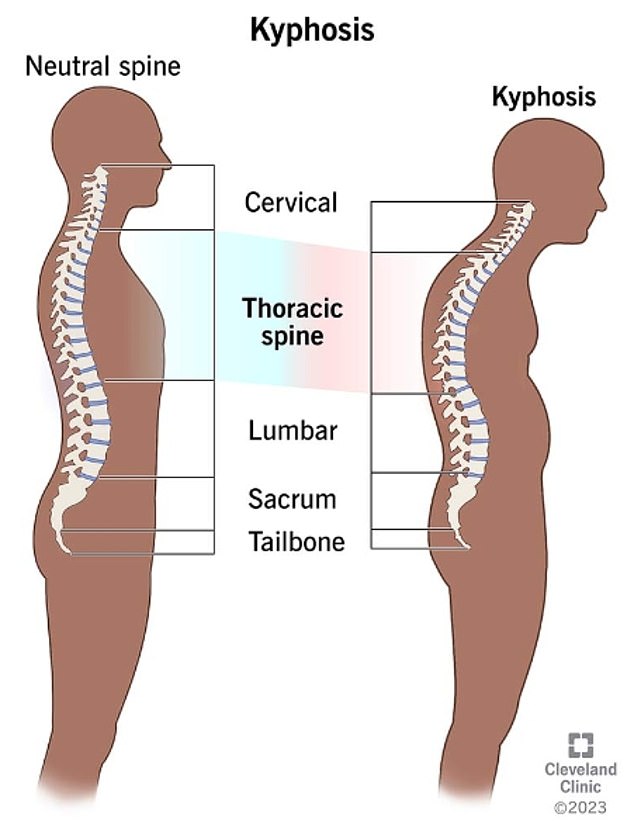A leading doctor has warned about the damage our phones are doing to our health, with a hunched back causing everything from incontinence to difficulty breathing.
Dr. Kuo-Pin Wu, a traditional Chinese medicine doctor, says smartphones and screens have become fixtures in our daily lives, but “constantly looking at them can reshape the curve of our spine.”
He warns that more and more people are developing kyphosis, also called round or humpback, an increasingly common condition that affects more than 3 million Americans per year.
The natural curve in the upper back is considered to be between 20 and 45 degrees on an x-ray, but a curve that exceeds 50 degrees is usually classified as kyphosis.
And Dr. Wu says the most common cause of this is “habitual forward head and neck posture, such as frequently looking at screens while working.”
In addition to looking unsightly, Dr. Wu says a hunchback can cause a variety of health problems, including poor posture, chronic pain, balance problems, and even loss of the ability to walk.
While scrolling for hours or sending hundreds of text messages a day is a major contributing factor to acquired hunchback, the condition can also be caused by “using a pillow that is too high, weak lower back muscles, or fractures from compression of the spine in the lumbar or thoracic region.
To avoid the many complications that come with a hunchback, Dr. Wu recommends doing daily overhead arm stretches and sleeping with a pillow under your knees to relieve pressure on your lower back and “promote a more natural alignment.
A leading doctor has warned of the damage our phones are causing to our health, as a hunched back causes our internal organs to be crushed.
The Cleveland Clinic says severe kyphosis can cause pPain or stiffness in the back and shoulder blades, tingling sensations in the legs, balance problems, and difficulty breathing when the chest is compressed.
It can also cause incontinence.
This is because slouching can compress the spinal cord or spinal nerves, disrupting communication between the brain and the muscles responsible for bladder control.
Dr. Wu says one study found that people with severe hunchback posture were “subject to increased loading on the muscles of the trunk and spine, which may accelerate spinal degeneration.”
Spinal degeneration, which usually occurs in adults over 40 years of age, occurs when the cartilage and discs in the spine wear out and lose their supporting function.
In more severe cases, degenerative disc disease can lead to a collapsing stage, which could mean you are confined to bed or a wheelchair.
Moving on to your internal organs, Dr. Wu says that a curved spine can have a negative impact on your ccardiovascular and respiratory function.
He explains: ‘Humpback posture can cause the ribs to compress inward, reducing lung capacity and potentially affecting heart and lung function.
“Symptoms can include heart palpitations, chest tightness, and frequent shortness of breath.”
The Framingham Study, the nation’s oldest large-scale analysis of cardiovascular disease, found that severe hunchback posture was associated with a rapid decline in lung function, especially in older women.
Lastly, Dr. Wu says that a hunched posture can negatively affect stomach function.

Kyphosis, also called round or humpback, affects more than 3 million people a year in the US.
As your internal organs are compressed by a curvature, this can lead to bloating and indigestion.
It cites a Japanese study that found that among adult patients undergoing surgery for spinal deformities, 52 percent experienced frequent symptoms of gastroesophageal reflux disease (GERD).
This is a digestive disorder that occurs when stomach acid returns to the esophagus.
To help correct a hump, Dr. Wu suggests several exercises including using your devices less frequently and daily overhead arm stretches.
He instructs: ‘Stretch your arms forward and raise them above your head. Start with your palms facing each other, then turn your palms outward as you raise your arms. Tilt your head slightly upward.
‘As you raise your arms, step forward with your right foot, lifting your left heel so that only your toes touch the ground.
‘Return to a neutral position, then step forward with your left foot and repeat the movement.
“Continue alternating sides and repeat the exercise 10 times.”
This exercise, says Dr. Wu, helps stretch the muscles and joints in the back, promotes lymphatic circulation under the arms, and increases oxygen intake.
He recommends doing it “several times a day, whenever you have time.”


